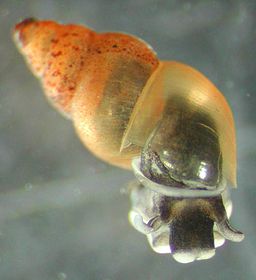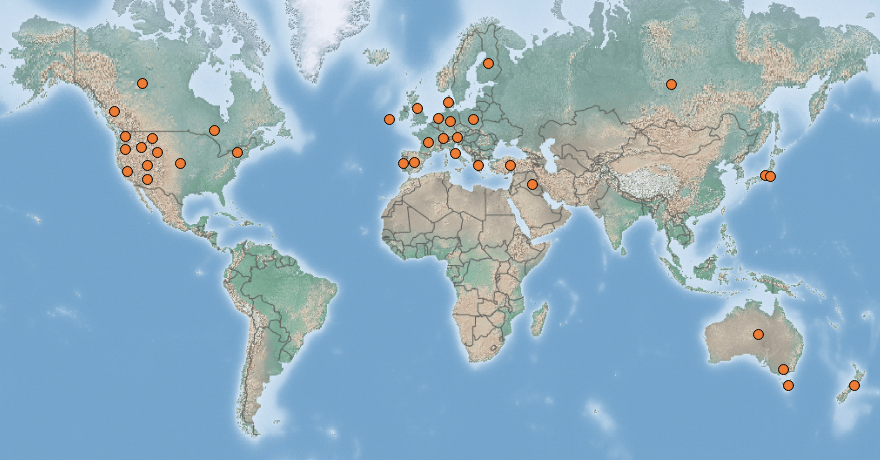 |
New Zealand mud snail | Status LU: established. 1st record: 1996. |
 |
Neiséilännesch Zwergdeckelschleek | Status Eur.: established. |
 |
Hydrobie des antipodes | RA: ISEIA: A3, Black List. Harmonia+: n/a. |
 |
Neuseeländische Zwergdeckelschnecke | Wikipedia: |
 |
Jenkins’ waterhoren | Back to the list of invertebrates |
Contents
Report the species
→ Report Potamopyrgus antipodarum to the National Museum of Natural History.
Brief description
 Potamopyrgus antipodarum (Gray, 1843) is an aquatic snail native to New Zealand. It has been introduced to Europe, North America, Australia, Iraq, Turkey and Japan. In several ecosystems it is considered invasive because it becomes highly abundant, impacting the structure and function of the invaded ecosystems. Females are parthenogenetic, meaning they can reproduce without males, so a population can be founded by a single female. Most the non-native populations are female. There can be up to six generations per year, with an average number of 230 offspring per adult per year. P. antipodarum can also tolerate desiccation for several days, which allows for rapid spread (such as by birds and fishing tools) throughout different aquatic ecosystems. In several countries, including Spain, USA and Australia, it is considered as an invasive species (CABI 2019).
Potamopyrgus antipodarum (Gray, 1843) is an aquatic snail native to New Zealand. It has been introduced to Europe, North America, Australia, Iraq, Turkey and Japan. In several ecosystems it is considered invasive because it becomes highly abundant, impacting the structure and function of the invaded ecosystems. Females are parthenogenetic, meaning they can reproduce without males, so a population can be founded by a single female. Most the non-native populations are female. There can be up to six generations per year, with an average number of 230 offspring per adult per year. P. antipodarum can also tolerate desiccation for several days, which allows for rapid spread (such as by birds and fishing tools) throughout different aquatic ecosystems. In several countries, including Spain, USA and Australia, it is considered as an invasive species (CABI 2019).
Status and distribution in Luxembourg
Records of Potamopyrgus antipodarum (Gray, 1843) in Luxembourg. Data source: Recorder-Lux, iNaturalist & GBIF, 2024-07-27.
Currently, 52 records of the New Zealand mud snail are accessible through the MNHNL-mdata portal (MNHNL, iNaturalist & GBIF 2019).
Risk assessment
ISEIA protocol
A3 (3+2+3+3) = Black List (Ries et al. 2017: 68).
Harmonia+ protocol
Not assessed yet.
Worldwide distribution
Bibliography
- CABI, 2019. Potamopyrgus antipodarum (Gray, 1843). In: Invasive Species Compendium. Wallingford, UK: CAB International. URL: www.cabi.org/isc [accessed 2020-04-21]
- MNHNL, 2000-. Potamopyrgus antipodarum (Gray, 1843) in Recorder-Lux, database on the natural heritage of the Grand Duchy of Luxembourg. Musée national d’histoire naturelle, Luxembourg. URL: https://mdata.mnhn.lu [Accessed 2019-10-24]
- MNHNL, iNaturalist & GBIF, 2019. Potamopyrgus antipodarum (Gray, 1843) in MNHNL-mdata, online portal combining species observation from Recorder-Lux, iNaturalist and GBIF. National Museum of Natural History, Luxembourg. URL: https://mdata.mnhn.lu [Accessed 2019-10-24]
- Ries, C., A. Arendt, C. Braunert, S. Christian, A. Dohet, A. Frantz, G. Geimer, M. Hellers, J. A. Massard, X. Mestdagh, R. Proess, N. Schneider & M. Pfeiffenschneider, 2017. Environmental impact assessment and black, watch and alert list classification after the ISEIA Protocol of invertebrates in Luxembourg. Bull. Soc. Nat. luxemb. 119: 63-70. [PDF 360 KB]
Suggested citation of this webpage
Ries, C. & M. Pfeiffenschneider (Eds.), 2024. Potamopyrgus antipodarum (Gray, 1843). In: neobiota.lu - Invasive Alien Species in Luxembourg. National Museum of Natural History, Luxembourg. URL: https://neobiota.lu/potamopyrgus-antipodarum/ [Accessed 2024-07-27].
Page content last updated on 2020-04-21.


